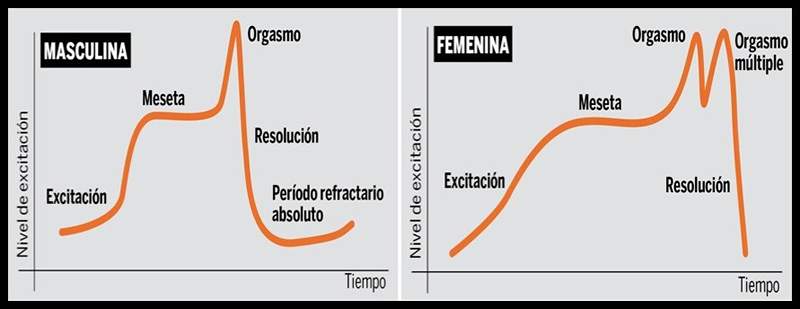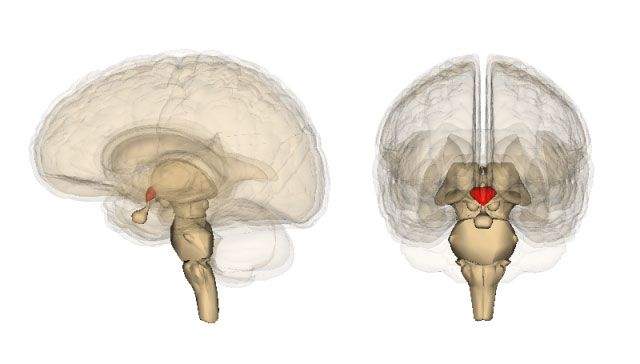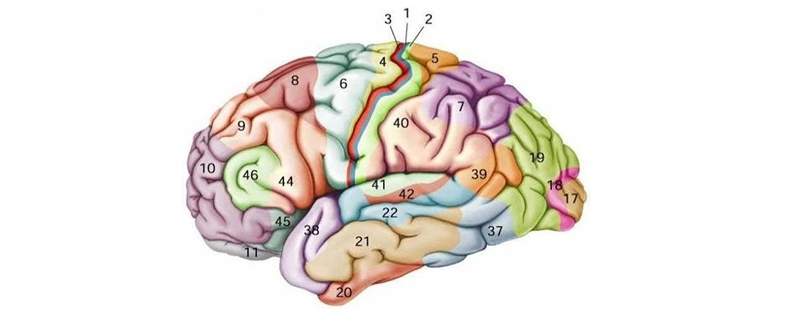What happens in our brain during orgasm?

- 1750
- 496
- Lorenzo West I
Women are able to pretend orgasm, but men can pretend an entire relationship.
He orgasm It is the great word dining room. It only allows the groan, the howl, the infrahuman expression, but not the word.
Psychology analyzes the behavior of people and the world of analysis goes from everyday life, going through the bizarre until reaching the sublime. However, it would be a very closed position, to think about our discipline as the only one capable of understanding the wonderful world around us. Assume an epistemologically more open and transdisciplinary strategy, puts us in the universe of understanding and complementing with other disciplines the understanding of human behavior such as sex and particularly orgasm.
Content
Toggle- A social neuroscientific approach
- The importance of sex in our lives
- The physical effects of orgasm
- Excitation phases to get to orgasm
- Excitement:
- Plateau:
- Orgasm:
- Resolution:
- Orgasm in the brain
- Orgasm studies
- The similarities of male and female orgasm
- The differences in male and female orgasms
- What intensifies orgasm?
- The different routes to achieve an orgasm
- Benefits of having orgasms
- Bibliography
A social neuroscientific approach
The approach used in this article starts from Social neuroscience, which studies the relationship between the neurological processes of the brain and social processes. This analysis not only emphasizes how the brain influences social interaction, but also how social interaction can influence the brain (Franzoi, 2007).
Our thoughts, emotions, feelings and behaviors influence us to act in different ways, but also The environment is molding our way of perceiving and facing reality.
The importance of sex in our lives
Sex is the lever that moves to the world, the axis whose around and all human acts turn and support, from the most resonant and international consequences to the most local and most local. Sex, among mortals, is the source of immense joys and also of great catastrophes (Dubois, 1999).
There are activities that catch people in general: eat, sleep, drugs, music and sex. If we did not have sex, we would be extinct on this planet. The importance of sex in our life is vital, although some people can live without it.
Harvard psychologist Daniel Gilbert, did a curious experiment in 2010 with men and women. With a sample of 2250 people, he placed an application to ask in random times the study subjects. What were they doing at that time and how happy they felt?. Being 0 the minimum and 100 the maximum well -being. Some activities and their scores are listed:
- Work, 61,
- Read, watch TV and take care of the children, 65,
- Shopping, 68
- Listen to music and talk, 74
- Exercise, 77
- Have sex with a couple, 92
The conclusion was obvious: sex is the activity that makes us happier, at least temporarily (Estupinyà, 2013).
 Summer: how our mood affects
Summer: how our mood affects The physical effects of orgasm
Orgasm is one of the four stages of human sexual response. The paths to reach orgasm are multiple as can be seen later: by the stimulation of the erogenous zones, by conditioning as it happens with some paraphilias (Looner porn and podophilia, they will be explained later), by training as it happens in some mystical practices as in the tantric sex, By oxygenation or electrical stimulation of the route of the sacred nerves (a dead person can experience an orgasm by stimulating this route, it is known as the reflex of Lázaro) and even having a cerebral paddling (touching the knee and reaching an orgasm).
The experience that On August 8, World Orgasm Day is celebrated. According to international studies, with sexual maturity orgasm is achieved more easily and faster (Diario Libre, 2016).
During an orgasm, not only are areas of the brain turn on, they also oxygenate and produce chemicals capable of strongly influencing our behavior. The chemical messengers that occur in specialized areas of the same, strongly influence social behavior. Hormones are influenced by neurons, but it is a reciprocal influence and are also influenced by the environment that surrounds us as social neuroscience points out.
Through neuroimaging techniques you can study the brain with luxury of detail, both in relation to the structure and brain function ”, as noted by Richard Haier, neuroscientist, Mind Research Network, UNIV. New Mexico (we can read the mind, 2011). These techniques generate "maps" of the brains of living people when examining their electrical activity, structure, blood flow and chemistry (Cunningham et al, 2003).
Excitation phases to get to orgasm
Since the time of classical Masters & Johnson studies, the same conclusion has been reached. In women, a cannon, an explosion, female orgasm is devastating, as described by Sophia Jeaneau (2014), in her film the orgasm of her.

The APA dictionary (2010) defines a orgasm as the climax of stimulation or sexual activity, When the maximum pleasure point is reached, which is characterized by the release of tension and rhythmic contractions of the perineal muscles, the anal sphincter and the pelvic reproductive organs. In men, orgasm is also accompanied by the issuance of semen (ejaculation); In women, it is accompanied by contractions of the wall of the outer third of the vagina.
Orgasm is a part of four phases that manifest both in men and women and that differ only in aspects determined by male or female anatomy:
Excitement:
- Women Vaginal lips swell and vaginal lubrication appears.
- Men: An erotic stimulus awakens libido. Vasocongestion is presented and cavernous bodies are filled with blood. This causes penis erection. It takes to occur among eight seconds in young men, while in the oldest and most gradual. The skin of the scrotum and the testicular bag and the testicles increase in size.
- Lasts between several minutes and several hours.
Plateau:
- Women: The uterus rises, the vagina expands and vaginal lips change color. Women need at least 20 minutes of sexual stimulation to enter climate and get to the maximum pleasure.
- Men: The excitement becomes constant and uniform. The glans takes a purple hue, because the vasocongestion increases. The testicles continue to rise and prepare for the next ejaculation, and their size increases until it is once and a half larger than usual. Cowper glands secrete a few drops of seminal fluid, to lubricate the tip of the penis. During this stage, 25% of men experience effects such as: the skin of different parts of the body covered with reddish spots; Similar to an eruption, the loss of control over the gestures of the face, breathing accelerates until sometimes reached the panting point.
Orgasm:
- Women: Contractions of the uterus and anus, and vaginal earthquake. Orgasm in a woman, lasts 6 to 10 seconds, although it can last 20 in some cases.
- Men: It is marked by ejaculation in men. Orgasm in men is four to five seconds.
Resolution:
- Women: The uterus descends and the vagina returns to normal. It can last only a few seconds.
- Men: Lasts between 15 minutes and one day. The tissues of the genital organs are emptied with blood, so half of the penis tension is lost (Jeaneau, 2014; APA, 2010; Silva, 2017; Diario Libre, 2016).
Described by women, an orgasm is a wave of pleasure, an intense sensation, it is the climax of pleasure, you feel heat and everything swells a little (the breasts, sex), there are many very pleasant sensations, you feel it for the whole body. "I shout and I have the feeling that it's like a song". "It is the union with the other, is when you feel that you are in communion with the other person".
Orgasm can reach different pathways (clitoris, vagina, nipples, stimulating desire, emotions and fantasies, the self -control of the vaginal walls, stimulation of the G -principle of the vaginal channel-, by stimulating point A - At the end of the vaginal channel, it is the one that provides an anal orgasm) and all of them are interpreted by the brain as an orgasm.
Desire is essential for orgasm, it is neurological, When someone is desired ardently the brain releases dopamine that increases pleasure (Jeaneau, 2014).

Orgasm in the brain
The brain has developed a response to fear to keep us out of danger, but is also endowed with a strong sexual impulse to ensure the survival of species. Helen Fisher mentions that: "Orgasm is one of the strongest experiences for humans, so scrutinize in the mind and discover how the brain produces that state of ecstasy is exciting. You receive a torrent of dopamine, dopamine is the same chemical compound that is activated when you consume cocaine and other stimulating drugs. It is an overwhelming experience of ecstasy and energy”(The human brain, 2016).
 Jealousy a natural weapon
Jealousy a natural weapon Orgasm studies
The experience of analyzing orgasm in the male and female brains is not exclusive to a single researcher, and in this titanic work many bright minds have intervened fortunately to unravel their mysteries.
In the Netherlands, the neuroscientist Greg Berns, began to make a way some years ago in the research on orgasm, showed for the first time what happens in the brain of man and woman, in a “pet” scanner, the blood flow is seen cerebral at the time of achieving it. The brain has many kilometers of blood vessels (if we could form all the arteria and capillary veins of a person, it would give it the return to the earth twice) and when the cells are working they need a lot of blood loaded with energy and rich in oxygen, when they are not working they need very little. And you can see that parts of the brain are active during ejaculation or orgasm.
The similarities of male and female orgasm
- We have similarities and differences at the brain level when we reach an orgasm, the most important coincidence is that both generate dopamine before the expectation of orgasm and in the consummation of the same. And, the control is taken by the autonomic nervous system, activating the brain stem. In addition to being the oldest part of the human brain, it is the area that controls the release of dopamine in the brain (dopamine is known as the pleasure hormone, regulates motivation and desire and makes us repeat behaviors).
- Also at the end of orgasm in both oxytocin, the hormone of calm, love and healing is released.
- Fear and anxiety decrease or disappear and the cerebral tonsil enters rest mode.
The differences in male and female orgasms
However, the differences are fascinating:
- Dr. Gert Holstege discovered that women's orgasms imply activity in the Accumbens nucleus, the anterior cingulate, the hippocampus, the hypothalamus and the preoptic area, while in the male orgasms the ventral tegmental area, the thalamus and the visual cortex intervene (Wheatley & Puts 2015). In both different dopamine routes are activated.
- The experiment showed that blood flow decreased in men in areas related to anxiety, but other areas remained on alert. In men there is a deactivation of the amygdala, of the areas that have to do with anxiety or fear.
- The deactivation in women, was the most important finding, there was a great deactivation in areas of the brain that have to do with anxiety, fear and surveillance. Apparently women leave, they can lose consciousness during orgasm.
- Dopamine accompanied by euphoria before orgasm is a common feature in both. However, then in men, it simply disappears and in women it goes down, but does not disappear (the human brain, 2016).
- A recent study demonstrated sexual differences in the pituitary (it is called the master gland, because it controls many of the functions of other glands) during orgasm, with female orgasm being associated only with the increase in activity in that region of brain. The Highest pituitary activation in women It was interpreted by the authors to mean higher plasma concentrations of oxytocin (Peace, relationship and rest hormone), a hormone that is released from the pituitary and is found in much higher plasma concentrations in women than in men after orgasm (Wheatley & Puts, 2015). If after orgasm the pituitary and oxytocin liberation in women are activated more, it could well be the cause of asking the couple to continue with kisses and caresses after reaching the climax.
- The oxytocin It is also known as the hormone of calm, love and healing. Dr. Kerstin Uvnäs Mober, is recognized throughout the world as an authority in oxytocin and points out in this regard: certain studies in human beings have shown the Spectacular increase in the blood oxytocin rate of both sexes at the time of sexual contact, which reaches the maximum during orgasm. After intercourse we often feel relaxed, or even numb. Sometimes it is at that time that we feel more in intimacy with our partner, and nothing matters more than being with the loved person (Uvnäs, 2009).

It is not surprising that in men and women areas of the brain are deactivated so that it does not feel anxiety or fear and we simply concentrate on orgasm. Evolutionary psychologists believe that this difference between men and women can have their origins in prehistory when we were collecting hunters. Women could be disconnected materially, but men had to be alert even after mating so as not to be eaten by some beast.
 Brodmann, Location and Function Areas
Brodmann, Location and Function Areas What intensifies orgasm?
Moving from a somewhat mechanical physiological reaction to a highly pleasant sensation in orgasm can be intensified through the following aspects:
- Unlike the penis, the only Purpose of the clitoris is to provide pleasure. Does not intervene with the reproductive process.
- Between 50 and 80% of women who reach an orgasm, They do it by clitoridial stimulation, with or without vaginal penetration.
- Con time the clitoris becomes bigger. At 35, it is four times larger than when the woman was 15. After 45, the seven times bigger than at birth. That is why older women reach orgasm faster.
- The clitoris It is not the only female orgasm zone inside and around the vagina. The point g (On the inside of the vagina), it is directly connected to the clitoris and is also a source of orgasms.
- It is the most sensitive female sexual organ, orgasms switch par excellence.
- The external part of the clitoris (glans, stem and body) contains more than 8 thousand nerve endings They connect with a network of more than 15,000 more nerve endings in the pelvic region. The penis has only 4,000 nerve endings.
- The clitoris orgasms are not lower than the vaginals, on the contrary, they have the same intensity And, strictly speaking, all orgasms occur because they connect with the clitoris through nerve endings.
- In 1998, the Australian Helen O'Connell managed to obtain the complete anatomy of the clitoris Thanks to magnetic resonance image studies made to volunteers. Before that date, only the external part of the clitoris was shown and the real volume of the erectile tissue (Meraz, 2014) was unknown.
The different routes to achieve an orgasm
Orgasm is a reflection of the autonomic nervous system, It is part of the nervous system that deals with the things we have no conscious control; Like digestion, heart rate, sexual excitement. And the orgasm reflection can be triggered by a wide range of stimuli (Roach M. (2009).
Experience orgasm; It can be done alone, as a couple, accompanied by accessories or utensils, accompanied by more people or even animals or other objects for some of us unconventional, the paths are as personal as they are chosen, the possibilities are almost infinite. And, they are experienced even stimulating areas of the body that have nothing erogenous.
It is clear that Orgasms are related to the reward system that generates dopamine. However, these neurons can answer when they are associated with some non -erotic stimulus and you are They also respond with an unexpected reward. In psychology this is known as conditioned stimulus and is to associate a neutral stimulus as Iván Pavlov did when a bell sounds and associate it with the presence of food from their dogs. If this activity was still repeatedly presented, later the dog began to salivate with only the sound of the bell and then there was talk of a conditioned stimulus. The sound of the bell associated with the presence of food, towards the salivate dog and then wait.
In simple words Routes to reach orgasm can be associated with any neutral stimulus (Dogs, feet, armpits, hair, urine or excrement, etc.) that associated with the production of dopamine and sexual contact naturally produces a behavior conditioning. If this is done repeatedly, when a neutral stimulus is presented and associated with sex in some modality as we can see later a paraphilia or a different way of obtaining dopamine associated with sex or orgasm.
And, they can result in a mixture of pleasure, pain, surprise, love, passion, eroticism, desire or only sex without love:
- Through masturbation or autoerotism (caressing, having fantasies, stimulating the clitoris)
- With body control, some women can produce an orgasm contracting the muscles of their vagina (Jeaneau, 2014).
- With oral sex or cunnilingus
- Through the experience of some paraphilia, such as the loon porn, people who inflate balloons (conditioned stimulus), play with them, or simply take them to the maximum resistance point until they stand and with it they get an orgasm.
- Experimenting a sexual partialism (erotic attraction for some other than the genitals, but with the same desire): podophilia or fetishism by feet, maschalagni or attraction for armpits, nasopily or erotic desire for the nose, tricophilia or attraction by hair and pygophilia or erotic desire for buttocks, masochism or experience pleasure and pain (physical or psychological) at the same time, uroophilia or yellow rain is experienced by contact Fetishism for contacting the couple with the excrement, eproctophilia a variety of coprophilia, is fetishism or taste for the gases of the couple (Roble, 2017). Zoophilia or bestialism sexual excitation of contact with animals, domnophilia or attraction for caressing and performing oral sex to a sleeping person until they awaken it, olfactophilia excite For the hair Dysmorphophilia sexual excitement by deformed people, choreophilia experience sexual excitement when dancing, agonophilia excite The list continues.
The diversity of reaching orgasm has more surprising paths and makes us know more and more.
Those who practice tantric sex can achieve orgasm with just concentrating and doing breathing exercises. Which requires preparation. Men even have something they call retrograde ejaculation and can last much more than what an average has a common human being.
The psychologist and scientific disseminator Mary Roach (2009) in her talk of Ted Talks mentions other different routes to reach orgasm, which corresponds to a cerebral paddling but that activates the same routes of pleasure at the brain level:
- A woman who achieves orgasm mentions when someone stroked her eyebrow.
- Points to knee orgasms reported in specialized literature.
- A woman who had orgasms every time she brushed her teeth, performing this Senso-Motora action. If I had this condition, I would surely have a very white teeth.
- A surprising fact is what a dead person can experience orgasm as a reflex act, it is known as Lázaro's reflection. The explanation is as follows: the headquarters of orgasm along the spinal cord is something that we call the sacred nerves. If one causes it, if stimulated with an electrode at the precise point, an orgasm is caused.

Benefits of having orgasms
- It disconnects almost entirely the brain of women.
- Partially disconnects the brain of men.
- Can Cure the hypo (Roach m. (2009).
- Tea Relax.
- Having orgasms and ejaculating according to British sexologist Roy Levin, could foster fertility and need to renew a week before it begins to develop abnormalities for fertilization.
- Improves blood flow, relaxes and oxygenates blood.
- Generates endorphins (natural analgesics), and by improving blood flow and oxygenating our torrent Decrease pains head, menstrual, toothands and many others.
- Makes us happier By releasing dopamine and allows us to analyze the problems more objectively and calm emotions (it makes us emotionally smarter).
- Generates one feeling of greater closeness With the couple by releasing oxytocin (the hormone of peace, love and healing).
- By increasing dopamine levels against stress hormone (cortisol) and Improve serotonin levels also fighting depression.
- For the effort that is made, having it burning calories (from 127 to 500) and helps fight insomnia. Produces postcoital narcolepsy and sleep like Angelito, And the person responsible for this effect are the large amounts of oxytocin that are released in the blood.
- To the Improve blood microcirculation, Improve the status of the skin and the functioning of our genitals. As well as, brain oxygenation.
- Generates close ties with the couple.
- Improve our self -esteem.
- Men who ejaculate more regularly have an incidence Minor of prostate cancer.
- A study conducted at the University of Wilkes in Pennsylvania observed that people who arrive at orgasm present an antibody that helps strengthen the immune system (Hermosilla, 2012).
Watermelon, garlic, blueberries, seafood, bitter chocolate, citrus fruits and nuts help to have more intense orgasms (Diario Libre, 2016).
Pheromones and their impact on our behavior
Bibliography
- APA (2010) Concise Psychology Dictionary, Editorial El Manual Moderno, Mexico.
- Cunningham w.TO., Johnson m. K., Gatenby J.C., GORE J.C. & Banji m.R. (2003) Neural Components of Social Evaluation, Journal of Personality and Social Psychology, 85, 639-649.
- Dubois e. (1999) Amor sex intimacy, overseas editors, Spain.
- Estupinyà p. (2013) S = Ex² The science of sex, editorial debate, Mexico.
- Franzoi s. L. (2007) Social Psychology, McGraw Hill Editorial, Mexico.
- Uvnäs k. (2009) Oxytocin The hormone of calm, love and healing, Obelisk Editorial, Barcelona.
- « Pheromones and their impact on our behavior
- THE PERSONALITY PROFILE UNDJ OF THE PERSONALITY TEST MYERS BRIGGS THE COMMANDER »

